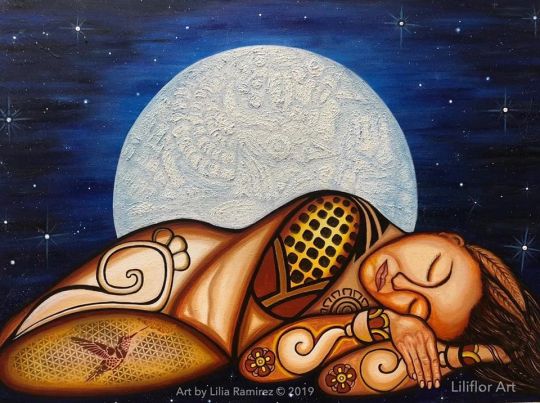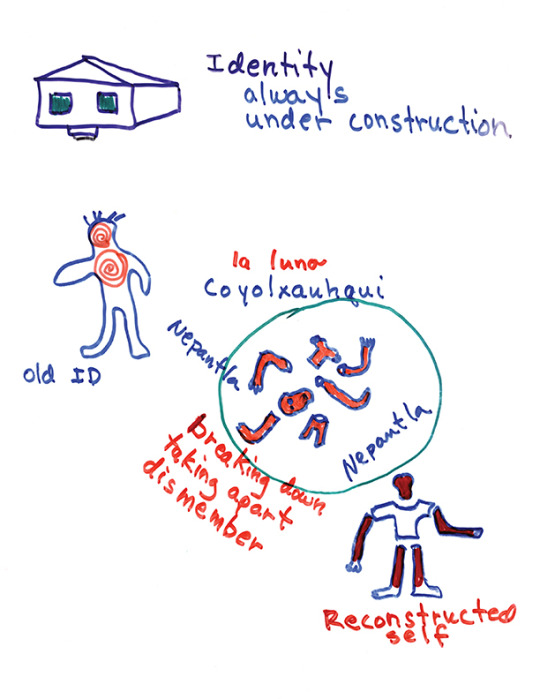Don't wanna be here? Send us removal request.
Text

"Dutiful Daughter” by Diana Lopez
In the story “Dutiful Daughter” by Diana Lopez, Juanita is in a state of nepantla. She is caught between two worlds, her aspirations and her family’s expectations. She wants to return to school and pursue a career in lab technology, but her parents want her to stay close and fill the role of a ‘dutiful daughter’. This conflict shows her internal struggle between her dreams and her cultural traditions. Juanita’s experience embodies the idea of nepantla, because she is torn between two different identities, one shaped by her Mexican heritage and the other by her personal dreams. Her story highlights the challenges of living with family pressure. Juanita struggles with self-doubt, especially after failing to perform well at work. Even though she is down on herself, she still continues to push forward and try to navigate her identities. By the end of the story, she understands that her mother’s expectations stem from a different cultural perspective, and that pursuing her own dreams does not make her a bad daughter. At the end of the story, she uses her application to dry blood on her hand. I think this symbolizes that she is not giving up on her dreams, but she is also hesitant. Juanita eventually finds a balance between honoring her family traditions and respecting her own dreams. Juanita finds peace in who she is. This story is powerful, and it shows how experiencing nepantla can lead to a deeper understanding of oneself and place in the world.
I chose this art by Mariela de la Paz because I think it symbolizes the state in which Juanita is in this story. In this picture, the women looks like she is in between two different worlds. One of which she desires more than the other. The left side of the picture with the tree in the butterfly I thought could represent Juanita's life is she pursued her dreams. The right side of the picture could represent the life her mother wants of her.
Indigenous Visionary Plant Medicine Art | Mariela de la Paz — Gallery
Author Diana Lopez
Ballet Nepantla El Jarabe Neoyorquino
0 notes
Text

“The Surprise Trancazo” by Helena Maria Viramontes
“The Surprise Trancazo” is a powerful story of the emotional battles that happen within families. The story portrays a family caught in a web of emotional tension. The main character, V. Rocha works hard every day in the military and is mentally exhausted while his younger sister, Guadalupe, is navigating her adolescence and getting in trouble with the mother who is struggling with her challenges of raising a family in a challenging neighborhood. At the end of the story when V. Rocha is walking home from work, he is confronted by three drunk white guys. They tell him to “go back to Mexico” and are obviously trying to start a fight. V. Rocha said, “just get back to your booze, I ain’t looking for nothin’.” The story proceeds to end with the three guys knocking V. Rocha unconscious onto the concrete and when he got back up, “slipping on his own blood,” and started throwing wild punches at them. The sound of cop sirens sent the three drunk men running and the story ends with V. Rocha getting arrested by the cops. This part of the story is hard to read as it puts into perspective the harsh reality that Mexican Americans faced in 1940. V. Rocha did nothing wrong, but it didn’t matter because his skin was brown he was going to get the short end of the stick. I think the authors main purpose is to take the reader into the times of the 1940s and give the reader a taste of what it was like to be brown in that time. V. Rocha was experiencing nepantla, because he lived in LA and worked for the United States but was treated as if he was a foreigner. This story was powerful.
I chose this art from Las Mujeres Muralistas because I thought it connects to how V. Rocha felt. The boy in the picture is facing two seperate directions but looks the exact same in both. I connected that to how V. Rocha was seen as a Mexican even though he was actually American.
Mujeres Muralistas: Pictorializing Latinoamérica in the Mission · SFMOMA
Analysis of Helena María Viramontes’s Stories – Literary Theory and Criticism
0 notes
Text

“Calle Martin De Zavala” by Francisco Cantu
Calle Martin De Zavala is a really interesting story about Fancisco and his mother looking for the house that her father was born in. Francisco’s mother moved to New York with her mom at a very young age, leaving her father behind. She never heard from her father after that and all she had to remember him by was a single photograph of him as a young man dressed as a Mexican charro, squinting under a broad sombrero with a pencil-thin mustache and a cigarette hanging loosely in his fingers. Francisco and his mother went to Monterrey, Nuevo Leon with a handful of photographs that helped them look for the house. They found the neighborhood and the street, Calle Martin de Zavala, and walked down the street trying to find the house that resembled the photograph they had from 1912. They ended up not finding exactly where her father was born. They ordered tacos from a women operating a food truck in her front lawn and conversed with her. The woman serving them shared more with them about her life and the place she came from than her father had. I think the main point the author is trying to convey is the importance of family. Even though Francisco’s mother never had her father, she still felt a connection with him. Francisco and his mother experienced a state of nepantla. Francisco did because he helped look for her father even though it didn’t affect him personally. He helped for the love of his mother. His mom was in a mental state of nepantla regarding her father. He wasn’t there to raise her, which made her see him in a negative light, but he’s also her father and she felt a certain connection to him. She was in between love and neglect for her father. This story is really interesting to break down, because you don’t know who is the main character, Francisco, or his mother. Regardless, it’s a great story and connects well to the themes of nepantla.
I chose this piece of artwork by Marisol Torres because I think it symbolizes how the mother felt in this story. The hand on her shoulder could represent the emotional battle with her father. The women looks as if she is at peace. The woman in this painting reminds me a lot of the Francisco's mother.
How this former Border Patrol agent learned to see through the eyes of those trying to cross
ABOUT — Francisco Cantú
0 notes
Text

Poetry
“Garden of Gethsemane” by Diana Marie Delgado
Garden of Gethsemane is a powerful poem. It’s short but conveys a deep emotional message to the reader. Delgado’s poem includes themes of trauma, identity, faith, and forgiveness. The speaker reflects on their own presence in this family dynamic, noting that there is a “speck of me” on the father’s face that he “never sees.” This speaks to the feeling of invisibility, of being overlooked or neglected. The second half of the poem endures a dramatic shift as it depicts the father waiting for his wife to cook him food with a black eye. This suggests that the father physically abuses the mother. The last line of the poem, “Can you forgive that?” is aimed at the father. Can the speaker forgive her father for patterns of violence and harm? At the beginning of the poem faith is a big theme. The speaker starts by “repairing silverfish on a station of the cross,” a reference to faith and Christianity. Repairing silverfish suggests that the speaker is in some form of repair, maybe trying to heal or deal with personal struggles. I think the mention of “when Jesus pulls me onto his lap,” symbolizes the speakers desire for comfort and divine protection. This poem connects to nepantla as the speaker is in-between emotional states, love and violence, belonging and alienation. The speaker living somewhere between those emotional states and it is a confusing complicated place to be. Overall, this poem is very powerful and connects to themes of nepantla, trauma, faith, and forgiveness. I though the last line was the perfect way to end the poem. End it with a question and leave the reader thinking.
I chose this picture because it depicts a women reaching out to find safety in religion. That idea connects well with this poem as the speaker finds comfort in faith to protect her.
POETRY — diana marie delgado
Diana Marie Delgado - Poetry.LA Interview - YouTube
0 notes
Text

“The Astronaut” by Matt Mendez
In “The Astronaut” the story revolves around a young boy named Carlos who has an incredible imagination that helps him cope with his struggles. One of the main points I think the author is trying to convey is the power of imagination. Carlos experiences mental nepantla in his inner conflict between dreams in his imagination and the reality of his life. He exists in a space between the world he is told to accept and the world he dreams of. I think the author is also demonstrating the way imagination and dreams can be a means of coping with trauma. Carlos lives in a rough neighborhood in poverty, but he uses his imagination to escape. Carlos’s family had gone through a lot of pain with the loss of many loved ones, including Carlos’s would be twin brother who died in the womb with him. Carlos’s mother, a waitress, works tirelessly to support the family and is unhappy with the way Carlos copes with the loss of his brother. Carlos’s mother creates altars once a year for the many loved ones who have passed in their family. Carlos’s brother comes back to life as baby skeleton and spends time with him. Carlos climbs to the roof of the apartment building with his brother and eats food from the altar up there. Carlos’s brother proceeds to disintegrate before his very eyes and turn to dust as his time was up. The story ends with Carlos running and jumping off the roof of the apartment building and floating to space to reconnect with his brother. This story is powerful and shows the significance of mental nepantla.
I chose this image from Liliflor Art because I think it does a good job of depicting someone dreaming. The moon and the night sky also connect with this story as the story ends with Carlos ascending into space. I feel this artwork connects with the power of imagination and dreams.
Liliflor Art
0 notes
Text

“Losing My Mother Tongue” by Reyna Grande
Losing my mother tongue by Regna Grande was really powerful and truly opened my eyes to the suffering that many Latinx immigrants endure in the United States. Reyna’s experience in 5th grade is heartbreaking. Her teacher made her feel ashamed to be a Spanish speaker. On the first day of school when the teacher realized she didn’t speak English, she pointed her to the farthest corner of the classroom and neglected her for the rest of the year. It’s hard to read about a child experiencing hate like that simply because they speak a different language. Reyna experienced mental nepantla when she was in junior high. She was enrolled in the ESL program along with all the other English learners. All the other kids made fun of them. They forced her to become fluent in English and never encouraged her to hold onto her native tongue. This led her to become trapped in between the two languages. She felt ashamed to use Spanish and didn’t know English well. In addition, another form of nepantla she experienced was her neighborhood in Los Angeles. Her neighborhood was mostly Latinx but within the borders of the United States. Therefore, she grew up in a physical space of nepantla. Personally, I find it so unfortunate that Reyna’s main takeaway after attending school was, “If I write in Spanish, I will be rejected. If I write in English, I will be celebrated and win prizes. The underlying message was that English would lead to success in this country.” It’s just a shame that our public-school systems have scared children from using their mother tongue. I really enjoyed this essay and found it eye opening.
I chose this picture by Linda Vallejo because Reyna Grande's story reminded me of it. The picture depicts the colonization of native lands. It reminds me how the United States pushed anyone aside who wasn't white and English speaking. Reyna's school fell in line with that same ideology, and pushed her aside on day one because she didn't speak English.
Linda Vallejo
0 notes
Text

“Life as Crossing Borders” by Sergio Troncoso
In Sergio Troncoso’s story, “Life as Crossing Borders”, he mentions many different experiences he has had in his life that represent nepantla. One of which was his experience growing up on the eastern outskirts of El Paso, Texas. Sergio states that “everyone was Mexican”, and that is what makes El Paso fit the idea of nepantla. Technically El Paso is in the United States, but it is so close to Mexico and predominantly Mexican. El Paso is neither American nor Mexican, it is in between or in nepantla. Sergio also mentions his experience of growing up with gang violence. He would make friends with tough characters as he would help them with their homework and they in return would protect him. More specifically, Sergio said he would help Willie roll joints in the back of Mr. Rittman’s class even though he had never smoked at the time. The was a state of nepantla, because he had never smoked but was helping Willie smoke. He was living 2 different lives almost. Another form of nepantla that Sergio experienced was the simple fact that he grew up in Ysleta in poverty and went to Harvard and then Yale for college. He was in-between because he was raised around poverty and then thrusted into a wealthy atmosphere. Sergio tells a very powerful story about when the cab driver drove him into Harvard Yard, he nervously asked him why he was taking him to a park. He was secretly worried that he might get kidnapped, because it sometimes happened in Mexico. That story is powerful and truly shows the effects that growing up in a gang heavy neighborhood can have one someone. I found this story to be inspiring. It shows that if you work hard and try your best, you can achieve anything. Sergio going to Harvard and Yale broke all the norms of someone who was raised in Ysleta. He got into those schools because he worked hard.
Anzaldúa across Borders: A Traveling Thought Gallery - PORTAL
0 notes
Text

Chicanx Artwork - El Paso
"Here, There" by David Dorado Romo
David Romo's personal essay is full of many experiences in his life that connect to the idea of Nepantla. He grew up in El Paso, Texas which in of itself is Nepantla because it technically is an American city but is overwhelmingly Latinx and Hispanic. He remembers Juan Predicador who would stand on the street corner singing church hymns while holding a Bible. David Romo says "And I always figured he said that because he was neither here nor there, or maybe he was both here and there simultaneously. Like almost everything and everyone on the border, including me. Here. There." I thought that quote from his essay describes Nepantla perfectly. David Romo also talks about his experience with having sex before marriage. His whole life he was told by the church and his pastors that having sex before marriage was wrong. His experience with his girlfriend Elizabeth on top of the Sante Fe International bridge sent him into a mental state of Nepantla. I love when David Romo said " I wasn’t supposed to love Lizzy the way I loved her, but I did. And it felt so good to be sinful. “If loving you is wrong, I don’t want to be right." He is in a state of Nepantla because his whole life he was told that it was wrong, but it felt right to him. This caused him to start to re-examine his faith and Christianity. I really found it interesting that when he started to learn Hebrew, he realized that almost every verse of the original version of the Bible had potentially different meanings than the translations we have now. That's fascinating to me because millions of Christians are told things their entire lives that could potentially be completely taken out of context or not mean what it was intended to mean. After he mastered a new language, he mentioned how he stopped going to church and lost his faith. I like his quote "Maybe I lost my old faith, but found a new one". This essay is interesting to me because it shows how David Romo gradually loses touch with himself and his beliefs that he has held since a young age and entered a liminal stage of personal transformation. This essay embodies the many different types of Nepantla that people can experience.
980f0ebd6408e2a3ee86fc4b195cdddd.jpg (2048×1360)
0 notes